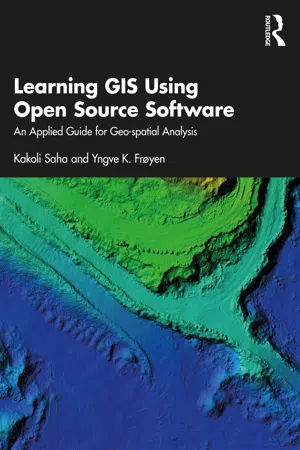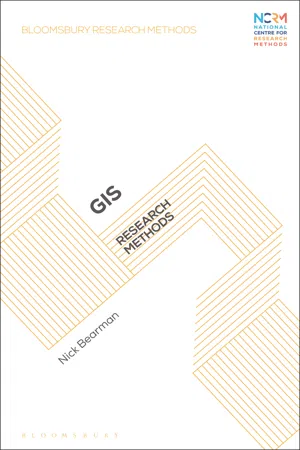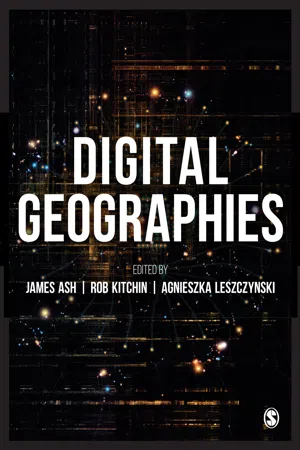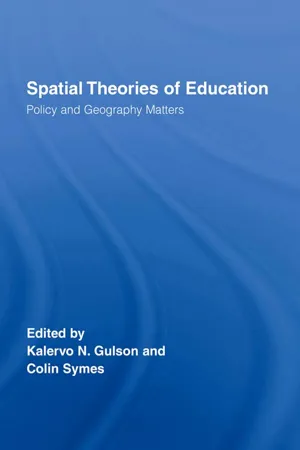GIS
GIS, or Geographic Information System, is a technology that captures, stores, analyzes, and presents geographic data. It integrates various types of data, such as maps, satellite images, and demographic information, to provide a comprehensive view of a location or area. GIS is widely used in urban planning, environmental management, natural resource exploration, and many other fields.
8 Key excerpts on "GIS"
- eBook - ePub
Learning GIS Using Open Source Software
An Applied Guide for Geo-spatial Analysis
- Kakoli Saha, Yngve K. Frøyen(Authors)
- 2021(Publication Date)
- Routledge India(Publisher)
...1 Introduction DOI: 10.4324/9781003056928-1 1.1 Concept and definition of GIS During its early stages in the 1960s, a Geographic Information System, or GIS, was merely a data processing software used in a small number of government agencies and universities only. These early developments were partly sparked by the need for resource and land management, partly also by the idea that mapping and map production could be made more efficient with the help of computer-based automation techniques. Today, GIS has become an important field of academic study. It has become part of the toolbox for many disciplines, not only academic or within societal management, but with the emerging smartphone technologies also an integrated part of most people’s information infrastructure. Searching for the whereabouts of objects and phenomena has become almost as available and common as searching for textual knowledge about the same. According to Lo and Yeung (2002), defining GIS is a complex task. Where some people perceive it as a branch of information, others see it as a field of academic study by focusing on its cartographic and spatio-analytical abilities. According to Rhind (1989), GIS is a combination of hardware and software systems, designed to capture, analyze and display the spatially referenced data to solve real-world problems. The United States Geological Survey (USGS, 1997) defined GIS as computer-based technology which can assemble, store, manipulate and display location data with geographic coordinates. In summary, GIS is a computer-assisted system that can manage geographically referenced data and use them to solve spatial problems (Lo & Yeung, 2002). 1.2 Components of GIS GIS engages several components in addition to those of data and technology, most importantly its applications, the people using it, and the people affected by its use...
- eBook - ePub
Digital Education Pedagogy
Principles and Paradigms
- Souvik Pal, Ton Quang Cuong, R. S. S. Nehru, Souvik Pal, Ton Quang Cuong, R. S. S. Nehru(Authors)
- 2020(Publication Date)
- Apple Academic Press(Publisher)
...In the new era, the science of where will be available in every corner of life and becomes a special interdisciplinary linkage. The concept of “location base” is becoming people’s thinking habit, so the need to use GIS is more and more urgent. The participation of GIS in education is necessary, it makes learners and teachers have basic life skills in the digital world. This chapter introduces the applications of GIS in teaching some modules at the undergraduate level for teaching subjects: Physics, Earth Science, Environmental Chemistry, and Ecology. 4.2 WHAT IS GIS? “A Geographic Information Systems (GIS) is a system designed to capture, store, manipulate, analyze, manage, and present spatial or geographic data” (Wikipedia). There are lots of different approaches when defining GIS. From a system perspective, GIS is an overall organization of four components: computer hardware, software, data, and people designed to operate effectively to receive, store, and control, analyze, and display all types of geographic data (Jeffrey and John, 1990; Otto Huisman, and Rolf, 2009): 1. Hardware: A system having a GIS system operates. 2. Software: Supply tools for containing, analyzing, and displaying geographic information. The main components in GIS software include: • Tools for importing and manipulating geographic information; • DBMS: Database management system; • Tools to support questions, analysis, and geographic demonstration; • Users interface for accessing easily. 3. Data: It can be considered as the main part in a GIS system. Combination of spatial data with other data sources will be organized data storage and management in GIS. 4. People: Is the key to success in the process of creating the system and the effectiveness of the system in the process of operating and exploiting...
- eBook - ePub
Geospatial Intelligence
Origins and Evolution
- Robert M. Clark(Author)
- 2020(Publication Date)
- Georgetown University Press(Publisher)
...Yet when asked exactly what it means, blank stares can be the result. At its most basic, GIS is a software and hardware combination capable of capturing, storing, manipulating, analyzing, and displaying geographic information (the GI). But that omits an essential component of the “system”—the S. The human analyst completes the definition when he or she properly defines the problem to be solved, crafts the relevant queries, and extracts the critical information (or intelligence, in the case of GEOINT) from GIS results. The GIS introductory discussion in chapter 6 was about layering visible images and maps. By the late 1980s, you could also layer different types of images—visible, spectral, and radar—or any combination. That development allowed analytic conclusions to be drawn that no one image type alone could offer. Furthermore, because spectral imagers provide many possible choices of spectral bands, it became possible to choose the most useful band in combination with a visible or radar image. The question was how to best display what GIS could deliver. Imagery had been used to produce maps (photogrammetry) since World War I. Maps were used to plan imagery missions. And imagery was being used to obtain terrain elevation for maps. If you’re going to move your tank battalions across the Iraqi desert, you need to know the terrain as well as the locations or possible locations of enemy forces. You don’t want to have to look at both maps and imagery to get that information. Visualization technology would allow you to have both in one electronic display with which you could interact. And this technology, known as geovisualization, has advanced remarkably in the last three decades. Geovisualization There are many versions of the saying that “one picture is worth a thousand words.” In the original Chinese proverb, the number is 10,000 words. Maps have a power that everyday language doesn’t possess. They can convey knowledge that cannot be easily passed on using just words...
- eBook - ePub
GIS for Planning and the Built Environment
An Introduction to Spatial Analysis
- Ed Ferrari, Alasdair Rae(Authors)
- 2019(Publication Date)
- Bloomsbury Academic(Publisher)
...Chapter 3 GIS: A Spatial Database of Our World Introduction Over the past half-century GIS has revolutionised the way that we visualise and analyse our world. It has opened up a world of computer assisted (geo-) graphical exploration, allowing spatial patterns and ordering within social and physical processes to be intuitively grasped and communicated using the power of maps. But to say that GIS is simply a graphical tool not only underplays its extraor-dinary power for analysing spatial relations between things, but also ignores the way that it can allow us to reimagine and rework ways of doing things. By allowing us to collect, store, manipulate and analyse large quantities of structured information about things on earth, GIS has enabled far-reaching shifts in the way that businesses, citizens and consumers view and find their way around ‘their’ world. Take Google. Google has risen to be the world’s foremost Internet company by understanding the latent value in information when it can be structured in a way that permits its widespread diffusion and use. Its mission is ‘to organ-ize the world’s information and make it universally accessible and useful’. Following the acquisition of mapping company Keyhole in October 2004, the Internet giant released its now ubiquitous Google Maps service the following year. The genius behind this move came from the realisation by Google that the maps and satellite imagery, while impressive, were of limited value by them-selves; but – as befits their mission – when used as a framework to organise information about everything else and to permit new ways of searching for information, we add a new dimension to the way we can grow and harvest knowledge. That is why ‘location services’ became the ‘killer app’ driving innovation and growth in mobile platforms...
- eBook - ePub
GIS
Research Methods
- Nick Bearman(Author)
- 2020(Publication Date)
- Bloomsbury Academic(Publisher)
...In 1997, the long-running journal International Journal of Geographical Information Systems changed its name to International Journal of Geographical Information Science to better reflect the changes in the academic discipline (Yuan, 2017). GIS has evolved over time, with the barrier to entry (in terms of computer power and technical skill) becoming progressively lower. The launch of Google Earth and Google Maps revolutionized GIS, including explaining what we do to our parents and grandparents (‘it’s like Google Earth, but you can edit and customize the data, and do analysis’). It also pushed software providers to make their programs much easier to use, which benefits everyone. The history is explored further in Chapter 2. What is social science? Now we know what GIS is, how do we apply this in social science? I am being fairly broad in my definition of social science, including anthropology, communication studies, economics, education, history, law, linguistics, political science, psychology, sociology as well as many other areas. Of course, geography is also a key part of social science, but many geographers know GIS already, so if you know GIS already this book is not for you. However, if you are a geographer and want to learn more about GIS, please read on! Geospatial data is vital in all of these areas and GIS can be applied across them all. For example, economists might look at how people’s spending power varies, either at a global scale (‘Big Mac Index,’ 2019 ; such as the Big Mac index, ‘The Big Mac index’, 2019) or within a town or city. In linguistics we might look at how language varies across the world or how it has moved across space and time (Luebbering, 2013). In literature, we might create some very nice maps of fictional worlds, such as the Lord of the Rings or Westeros (Game of Thrones)...
- eBook - ePub
- James Ash, Rob Kitchin, Agnieszka Leszczynski(Authors)
- 2018(Publication Date)
- SAGE Publications Ltd(Publisher)
...11 Cartography and Geographic Information Systems David O’Sullivan Introduction The default form of the map today is a web map, viewed on a phone or other internet-enabled device, responsive to the location and movement of its viewer, often overlaid with information tailored to the particular user. Underpinning the production of such maps are digital cartography and geographic information systems (GIS). The former can be thought of as the theories, practices, and institutions that combine to produce maps of all kinds (today’s paper maps are also digital products), while the latter are the computational infrastructure that underpins the storage, manipulation, management, and analysis of geospatial data. GIS exists on traditional desktop software platforms, and more commonly now on distributed computing systems, whether in client–server, peer-to-peer, or cloud architectures. Digital cartography and GIS share some common ancestry in the spatial science of the late 1950s and early 1960s. Experiences with learning to program, computer punch cards, and the frustrations of limited computing resources loom large in accounts of this period (see the many reminiscences in Stimson, 2008), and make clear that this was when geography made its first steps towards computation and the digital. For many, digital cartography and GIS are synonymous. They are certainly related, but their parallel evolution as fields of study and of practice since the Second World War is complicated, and has often been more separate than is assumed. These interrelated but distinct histories may originate in cartography’s long-standing dual identity as both science and craft (see, for example, Brewer, 1994), as compared with the more self-consciously academic path of GIS, especially following its reinvention as geographical information science (GIScience), which explicitly sought to emphasize theoretical underpinnings over practical applications (Goodchild, 1992)...
- eBook - ePub
Spatial Theories of Education
Policy and Geography Matters
- Kalervo N. Gulson, Colin Symes(Authors)
- 2007(Publication Date)
- Routledge(Publisher)
...However, there are three key components to a GIS (Heywood et al. 1998): that it is a computer system, incorporating hardware and software; that it uses spatially referenced data; and that it provides management and analytical capabilities. In effect it is a form of database tool that implicitly references the data over the Earth’s surface. Furthermore, just like other technological developments used in social science research, such as statistical software and computer-aided qualitative data analysis software, the operator or user of the GIS is critical in ensuring it is used appropriately and that its capabilities are enhanced. Generic GIS software is readily available from major suppliers such as ESRI and MapInfo. Even Microsoft is now incorporating GIS technology into its Office software. One of the reasons why GIS is being increasingly used in social science research is due to parallel developments in the role, collection, and availability of postcode data (Martin 1996). Postcodes have provided an easy and efficient source of geographical information. In the UK the government-funded Office for National Statistics (ONS) produces the All Fields Postcode Directory (AFPD). This contains all the postcodes used in the UK and identifies the administrative, health, electoral, and other geographies in which they are located. This has meant it is relatively straightforward to link individual households, via their postcodes, to other geographical information. It is also possible to spatially reference these postcodes for analytical purposes; for example, in measuring their proximity to key service providers. Postcodes can be spatially referenced in two ways: First, as a geographic area. The majority of postcodes represent an area that includes a particular number of households, approximately 15 households per unit postcode (Raper et al. 1992)...
- eBook - ePub
- Rattan Lal(Author)
- 2017(Publication Date)
- CRC Press(Publisher)
...Land Use: Planning and Geographic Information System (GIS) Egide Nizeyimana Department of Agronomy and Environmental Resources Research Institute, Pennsylvania State University, University Park, Pennsylvania, U.S.A. Jacob Opadeyi Department of Surveying and Land Information, University of West Indies, Saint Augustine, Trinidad and Tobago Abstract Geographic information system (GIS) and related technologies (e.g., remote sensing and global position system) have proven to be a valuable tool in land use planning activities. The GIS approach is important in this area because it provides functions to capture, store, organize, and analyze spatially referenced data. Moreover, GIS has been coupled to a variety of models (e.g., crop productivity, hydrology, and water quality simulations) and may be an important component of spatial decision support systems and land resource information systems. GIS enhances model flexibility and efficiency in these systems where it is often regarded as a centralized data analysis, management, and planning system. As a result, decision-makers and land use planners in private companies, in universities, and at various levels of the government are using GIS to develop spatial environmental databases, perform land evaluations, and analyze and manage resources. There is no doubt that the use of GIS and GIS-based systems in land use planning activities will continue to increase in the future, as more detailed digital environmental data sets become available and the capability of computers to handle large volumes of data increases. INTRODUCTION Agricultural scientists are required to provide information needed to address land degradation and land use conflicts confronting the world. As the population increases and land becomes a commodity in many parts of the world, careful planning of the use of land must be undertaken to accommodate conflicting people’s needs and preserve and/or protect the environment...







